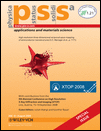Submicron resolution X-ray diffraction from periodically patterned GaAs nanorods grown onto Ge[111]
Abstract
We present high-resolution X-ray diffraction pattern of periodic GaAs nanorods (NRs) ensembles and individual GaAs NRs grown catalyst-free throughout a pre-patterned amorphous SiNx mask onto Ge[111]B surfaces by selective-area MOVPE method. To the best of our knowledge this is the first report about nano-structure X-ray characterization growth on non-polar substrate. The experiment has been performed at home laboratory and using synchrotron radiation using a micro-sized beam prepared by compound refractive lenses. Due to the non-polar character of the substrate the shapes of NRs appear not uniform and vary between deformed hexagonal and trigonal in symmetry. Because the average diameter of NRs equals the experimental resolution certain cuts through slightly inclined edges or corners of individual NRs with lateral size of about 225 nm could be selected using spatially resolved reciprocal space mapping.




